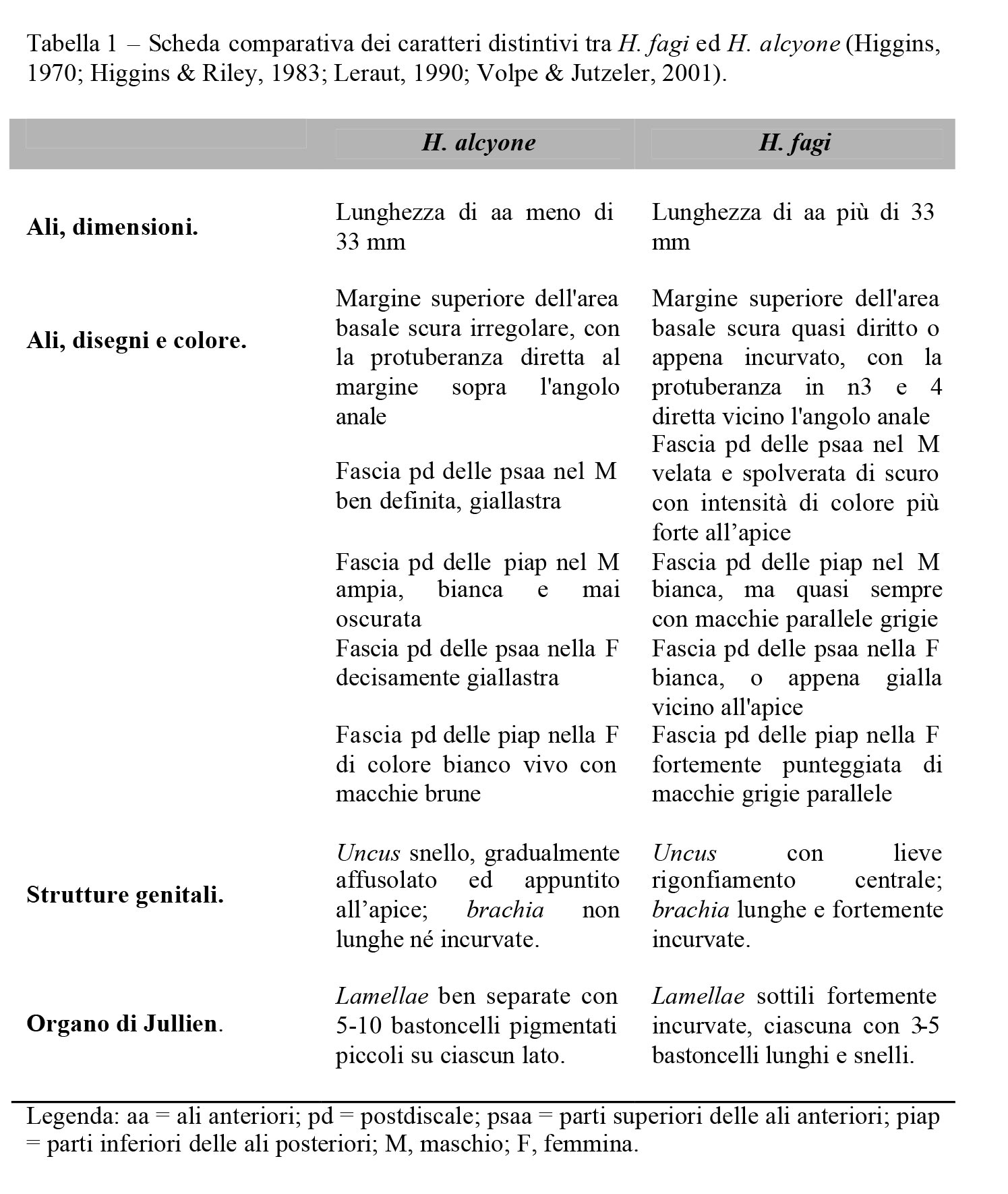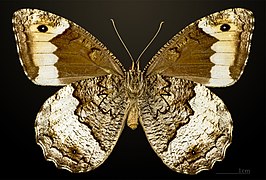Hipparchia (Hipparchia) fagi – Scopoli, 1763
Descrizione
Farfalla diurna della famiglia dei Ninfalidi.
È una farfalla abbastanza comune in centro Italia, in pianura e in collina, generalmente al di sotto della quota di m 1200 s.l.m.; è presente in tutta Italia a eccezione della Sardegna e dell’isola d’Elba.
La pagina inferiore è ricoperta da disegni mimetici, piuttosto caratteristici.
Ha una sola generazione annuale. Lo sfarfallamento avviene in piena estate.
Il bruco si nutre di Graminacee.
Il volo di questa farfalla è particolare: si alza velocissima in cielo, si posa per un istante e riparte, scomparendo in breve alla vista per poi riapparire, e così via.
Specie simile
Hipparchia alcyone – Denis & Schiffermüller, 1775
Le differenze tra le due specie le prendiamo da un bel lavoro (TESI per DOTTORATO DI RICERCA IN BIOLOGIA EVOLUZIONISTICA ED ECOLOGIA di Manuela Pinzari, Docente Guida: Prof. Valerio Sbordoni, Coordinatore: Prof. Patrizia B. Albertano) trovato facendo una ricerca su internet; questo lavoro presenta una tabella comparativa che illustra benissimo come distinguere le due specie:

A noi spetta il compito di evidenziare che probabilmente, spesso, si tratta di un lavoro per specialisti.
Hipparchia fagi
 Link da Moths and Butterflies of Europe and North Africa [www.leps.it]: Hipparchia (Hipparchia) fagi – Scopoli, 1763
Link da Moths and Butterflies of Europe and North Africa [www.leps.it]: Hipparchia (Hipparchia) fagi – Scopoli, 1763
| Hipparchia fagi | |
|---|---|

| |
| in Andorra | |

| |
| male, Republic of North Macedonia | |
| Scientific classification | |
| Domain: | Eukaryota |
| Kingdom: | Animalia |
| Phylum: | Arthropoda |
| Class: | Insecta |
| Order: | Lepidoptera |
| Family: | Nymphalidae |
| Genus: | Hipparchia |
| Species: | H. fagi
|
| Binomial name | |
| Hipparchia fagi | |
| Synonyms | |
Hipparchia fagi, the woodland grayling, is a butterfly of the family Nymphalidae.[3]
Etymology
The Latin species name fagi, meaning of "beech" (=fagus), refers to the prevailing species of trees in the relating biotope.
Subspecies
- Hipparchia fagi tetrica Fruhstorfer, 1907[2]
Distribution and habitat
This widespread European endemic species can be found in most of Europe, mainly south of the Alps[2] (Albania; Andorra; Austria; Bosnia and Herzegovina; Bulgaria; Croatia; Czech Republic; France; Germany; Greece; Hungary; Italy; Macedonia; Montenegro; Portugal; Romania; Russia; Serbia; Slovakia; Slovenia; Spain; Switzerland; Ukraine).[4] It occurs on broad-leaved deciduous forests, coniferous woodland, grassy vegetation, in woodland glades and woodland rides and, from sea level to 1,600 m elevation.[5]
Description
Hipparchia fagi has a wingspan of 66–76 millimetres (2.6–3.0 in).[6] These large butterflies have dark brown uppersides of the wings, with a fringed margin, a white submarginal band more evident in the females and one black eyelet at the apex of each forewings. In the males the white band has a single very small eyelet on each hindwing, sometimes showing a white pupil, while in the females it shows one or two ocelli.[7]
The underside of the forewings is rather similar to the upperside: The hindwings are marbled of brown and white with a broad white band. The white band on the internal edge of the underside hindwings is curved, while the white band on the underside forewings is often without a significant indent.[8]
The colouration and pattern of these butterflies are an excellent camouflage on the bark of the trunks where the butterfly usually rests, with the eyespots hidden by the closed wings.[5] This species is similar but larger than Hipparchia hermione. It is also rather similar to Hipparchia syriaca and Hipparchia genava.
The caterpillar has a pale brown head with four darker streaks. Body is light brown with a bifid posterior end, a dark brown dorsal band and brownish lateral bands.[9]
-
female
-
courting - female on the left
-
mating - female on the right
-
Female
-
Female underside
-
Male
-
Male underside
Biology
Adults fly from June to September.[6] This species has one generation a year. The caterpillars overwinter. The larvae feed on various types of grass, such as Brachypodium pinnatum, Bromus erectus, Festuca rubra, Holcus lanatus and Holcus mollis.[2][5]
Bibliography
- Kudrna, O. (1977): A Revision of the Genus Hipparchia Fabricius. — 300 S., Faringdon – London
- Kudrna, O., Harpke, A., Lux, K., Pennerstorfer, J., Schweiger, O., Settele, J. & M. Wiemers (2011): Distribution atlas of butterflies in Europe. – 576 S.; Halle a.d. Saale
- Lionel G. Higgins et Norman D. Riley, Guide des papillons d'Europe, Delachaux et Niestlé, 1988, (Lausanne).
- Tom Tolman, Richard Lewington, Guide des papillons d'Europe et d'Afrique du Nord, Delachaux et Niestlé, (ISBN 978-2-603-01649-7).
References
- ^ INPN taxonomie
- ^ a b c d "Hipparchia Fabricius, 1807" at Markku Savela's Lepidoptera and Some Other Life Forms
- ^ Catalogue of life
- ^ "Fauna europaea". Archived from the original on 2016-03-04. Retrieved 2017-02-17.
- ^ a b c IUCN Red List
- ^ a b Simon Coombes Captain's European Butterfly Guide Archived 2019-07-22 at the Wayback Machine
- ^ Papillons du Poitou-Charentes
- ^ Euro Butterflies by Matt Rowlings
- ^ D.J. Carter et B. Hargreaves, Guide des chenilles d'Europe, Delachaux et Niestlé, 2001, ISBN 2-603-00639-8
External links
- Paolo Mazzei, Daniel Morel, Raniero Panfili Moths and Butterflies of Europe and North Africa
- Larvae of North-European
- Lepiforum.de
Hipparchia alcyone
 Link da Moths and Butterflies of Europe and North Africa [www.leps.it]: Hipparchia (Hipparchia) alcyone – Denis & Schiffermüller, 1775 sinonimo Hipparchia (Hipparchia) hermione – Linnaeus, 1764
Link da Moths and Butterflies of Europe and North Africa [www.leps.it]: Hipparchia (Hipparchia) alcyone – Denis & Schiffermüller, 1775 sinonimo Hipparchia (Hipparchia) hermione – Linnaeus, 1764
| Hipparchia hermione | |
|---|---|

| |
| Scientific classification | |
| Domain: | Eukaryota |
| Kingdom: | Animalia |
| Phylum: | Arthropoda |
| Class: | Insecta |
| Order: | Lepidoptera |
| Family: | Nymphalidae |
| Genus: | Hipparchia |
| Species: | H. hermione
|
| Binomial name | |
| Hipparchia hermione (Linnaeus, 1764)
| |
| Synonyms | |
|
Hipparchia alcyone [Denis & Schiffermüller], 1775 | |
Hipparchia hermione, the rock grayling, is a butterfly of the family Nymphalidae.[1] The species can be found in Central Europe, Southern Europe, Eastern Europe, North Africa, Anatolia and the Caucasus.
The wingspan is 27–34 millimetres (1.1–1.3 in).The ground colour is dark brown. There is a white submarginal band, bordered with an interrupted fringe and a large black ocellus at the apex of the forewing. The hindwing has a small ocellus with a very discrete pupil
The underside of the forewing is similar: brown with a white submarginal band and the black ocellus with white pupil at the apex, while the hindwing is marbled with brown and white with a broad white band. No sexual dimorphism.
Similar to Hipparchia fagi, but on the underside the deep dark basal area of both wings contrasts much more sharply with the light band, and the latter, which is almost pure white on the hindwing, contrasts again conspicuously with the broad dark distal margin. The conspicuousness of the pattern on the underside of the hindwing is especially noticeable in the male, but even in the duller coloured female the band on the hindwing beneath is still quite distinct, although sparsely irrorated with black.[2]
It is smaller than fagi.

The butterflies fly from June to September on steep rocky slopes, in open forest, margins and forest clearings and in shrubland.
The larvae feed on various types of grass.
Footnotes
- ^ Hipparchia hermione at euroButterflies by Matt Rowlings
- ^ Seitz, A. in Seitz. A. ed. Band 1: Abt. 1, Die Großschmetterlinge des palaearktischen Faunengebietes, Die palaearktischen Tagfalter, 1909, 379 Seiten, mit 89 kolorierten Tafeln (3470 Figuren)
 This article incorporates text from this source, which is in the public domain.
This article incorporates text from this source, which is in the public domain.
External links
![Hipparchia faci, satiro del faggio [da wikimedia, foto di Joan Carles Hinojosa Galisteo Own work, CC BY-SA 3.0, commons.wikimedia.org/w/index.php?curid=16809875]](https://www.montagneaperte.it/ambienteebiodiversita/wp-content/uploads/sites/9/2016/11/Hipparchia_fagi_anvers-wikimedia-560x560.jpg)








